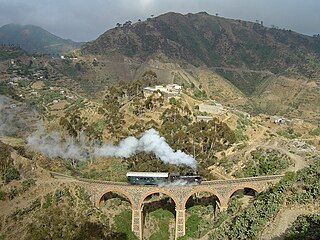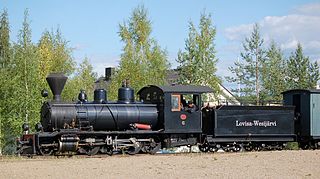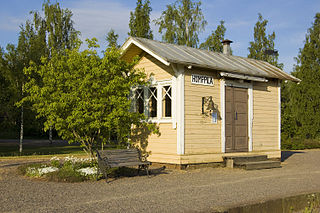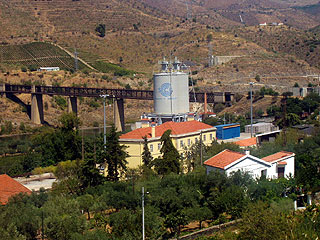
A heritage railway or heritage railroad is a railway operated as living history to re-create or preserve railway scenes of the past. Heritage railways are often old railway lines preserved in a state depicting a period in the history of rail transport.

VR Group, commonly known as VR, is a government-owned railway company in Finland. VR's most important function is the operation of Finland's passenger rail services with 250 long-distance and 800 commuter rail services every day. With 7,500 employees and net sales of €1.251 million in 2017, VR is one of the most significant operators in the Finnish public transport market area.

The Eritrean Railway is the only railway system in Eritrea. It was constructed between 1887 and 1932 during the Italian Eritrea colony and connects the port of Massawa with Asmara. Originally it also connected to Bishia. The line was partly damaged by warfare in subsequent decades, but was rebuilt in the 1990s. Vintage equipment is still used on the line.

Humppila is a municipality of Finland.

Jokioinen is a municipality of Finland.
Under the Whyte notation for the classification of steam locomotives, 2-8-2 represents the wheel arrangement of two leading wheels on one axle, usually in a leading truck, eight powered and coupled driving wheels on four axles and two trailing wheels on one axle, usually in a trailing truck. This configuration of steam locomotive is most often referred to as a Mikado, frequently shortened to Mike.

The Finnish railway network consists of a total track length of 9,216 km (5,727 mi) of railways built with 1,520 mm Russian gauge track having electrified track length of 3,249 km (2,019 mi) electrified track length. Passenger trains are operated by the state-owned VR which covers track length of 7,225 km (4,489 mi). They serve all the major cities and many rural areas, though railway connections are available to fewer places than bus connections. Most passenger train services originate or terminate at Helsinki Central railway station, and a large proportion of the passenger rail network radiates out of Helsinki. VR also operates freight services. Maintenance and construction of the railway network itself is the responsibility of the Finnish Rail Administration, which is a part of the Finnish Transport Agency. The network is divided in six areal centres, that manage the use and maintenance of the routes in co-operation. Cargo yards and large stations may have their own signalling systems.

The Jokioinen Museum Railway is located in Jokioinen, Finland. It is located on the last operating commercial narrow gauge railway in Finland, the 750 mm gauge Jokioinen Railway.

Humppila railway station is located in the municipality of Humppila in the region of Tavastia Proper in Finland.

Humppila museum railway station or Humppila-Museorautatie by its official designation is the northernmost railway station at the end of the line of Jokioinen Museum Railway. The station is located in Humppila municipality in Finland, and it is located almost directly across the tracks of Turku–Tampere railway line from Humppila railway station.

Jänhijoki railway bridge is a railway bridge in the village of Minkiö railway station in Jokioinen municipality, in the Tavastia Proper region of Finland. The bridge crosses the Jänhijoki river approximately 0.5 kilometres (0.3 mi) south of Minkiö railway station on the narrow gauge Jokioinen Museum Railway.

Minkiö railway station is a neighborhood of the Kiipu village and a railway station at the Jokioinen Museum Railway, situated north of the Minkiö village on the northern shore of the river Jänhijoki, and on the western side of the Jänhijoki village in the municipality of Jokioinen. The neighborhood which developed around the railway station is located about eight kilometers from the center of Jokioinen and about eight kilometers from Humppila.
The Otavi Mining and Railway Company was a railway and mining company in German South West Africa. It was founded on 6 April 1900 in Berlin with the Disconto-Gesellschaft and the South West Africa Company as major shareholders.

The Flekkefjord Line is a 17.1-kilometre (10.6 mi) abandoned branch line to the Sørland Line. It ran between Sira and Flekkefjord in Agder, Norway. The only current activity on the line is tourist draisines. The station buildings along the line were designed by the architect Paul Armin Due—these have all been demolished.

Jokioinen station is the southernmost station on Jokioinen Museum Railway. The station is located 14.2 kilometres (8.8 mi) from the Humppila station, in the municipality of Jokioinen in Finland.

VR Class Pr1 was a tank steam locomotive for local passenger services of Finnish railways.

The Sabor line(Linha do Sabor) was a 1,000 mmmetre gauge railway in north-east Portugal. It ran for nearly 106 km between Pocinho and Duas Igrejas, near Miranda do Douro. It closed in 1988.

The Finnish VR Class Pr2, nicknamed "Henschel", was a passenger tank class ordered from the Henschel & Son locomotive workshops by the Estonia State Railways in the spring 1939 and completed in 1941. The outbreak of the Second World War prevented their delivery to Estonia, but at least a few of these engines did manage to operate in Latvia in 1942. These engines became superfluous, because the Germans were converting the Baltic tracks to standard gauge, and so Finland could purchase these four engines. They were classified Pr2 and numbered 1800–1803 after their arrival in December 1942. The Pr2 tank engines were quite advanced locomotives, based on the Henschel Class 62 tank engine design of 1928. After their initial problems were solved, they proved to be fast runners and an ideal addition to the motive power roster. They were originally built by as oil-burners, and reverted to this type of fuel between 1947 and 1954 when oil prices were low. The Pr2 was very fast with its 1,830 mm wheel diameter. One of the Pr2 engines achieved 144 km/h during a test trial run. No. 1803, the final Pr2 in service, was withdrawn in May 1960. Only No. 1800 has been preserved at Haapamäki.

The VR Class Ds1 was the first railbus of the Finnish State Railways. It was ordered in 1927. The Ds1 was built by the Pasila workshop, but the automotive parts including the engine were supplied by the Swedish company DEVA. Ds1 has a diesel engine and an electric drive, with a diesel generator providing power to the wheels. A cab is at either end of the vehicle, so that the vehicle did not have to be turned at terminal stations. The vehicle consisted of a motor room, a luggage compartment, and a 3rd class passenger compartment bare on a wooden bench seating.

The passenger train locomotives number 27–29 of Stockholm–Roslagens Järnvägar, usually referred to as stortyskarna, were the largest steam locomotives ever built for the Swedish three foot gauge railways. Initially used in fast passenger trains from Stockholm to Rimbo and Hallstavik, they were moved to freight service after the Stockholm–Rimbo Line was electrified in 1946. They hauled iron ore from Dannemora mine and transporter wagons from Uppsala, but were replaced by diesel locomotives during the 1950s. Two locomotives were leased at different times to the narrow-gauge network in Västergötland. Their last service was between Rimbo and Hallstavik in 1960. SRJ 28 has been preserved.


















